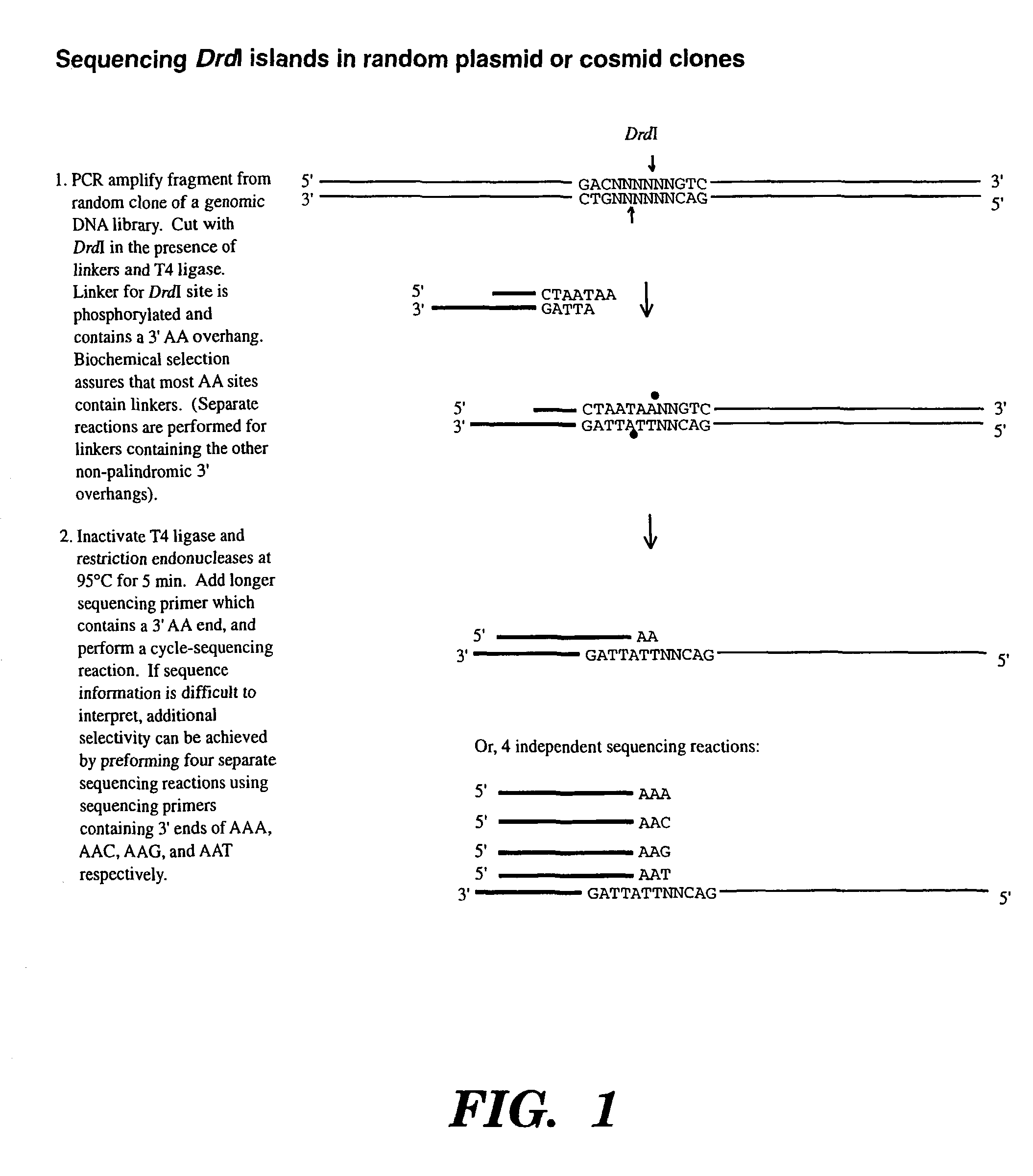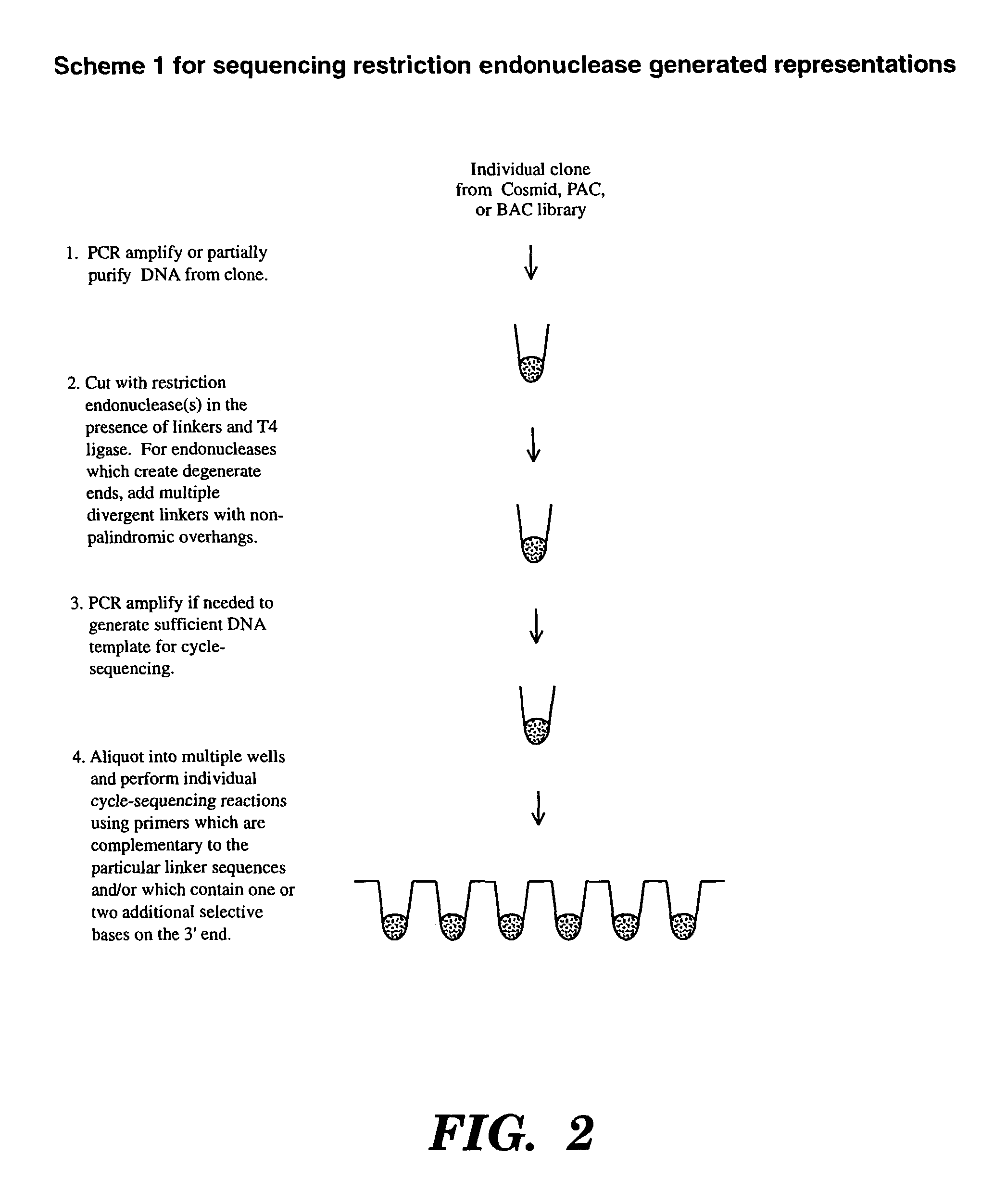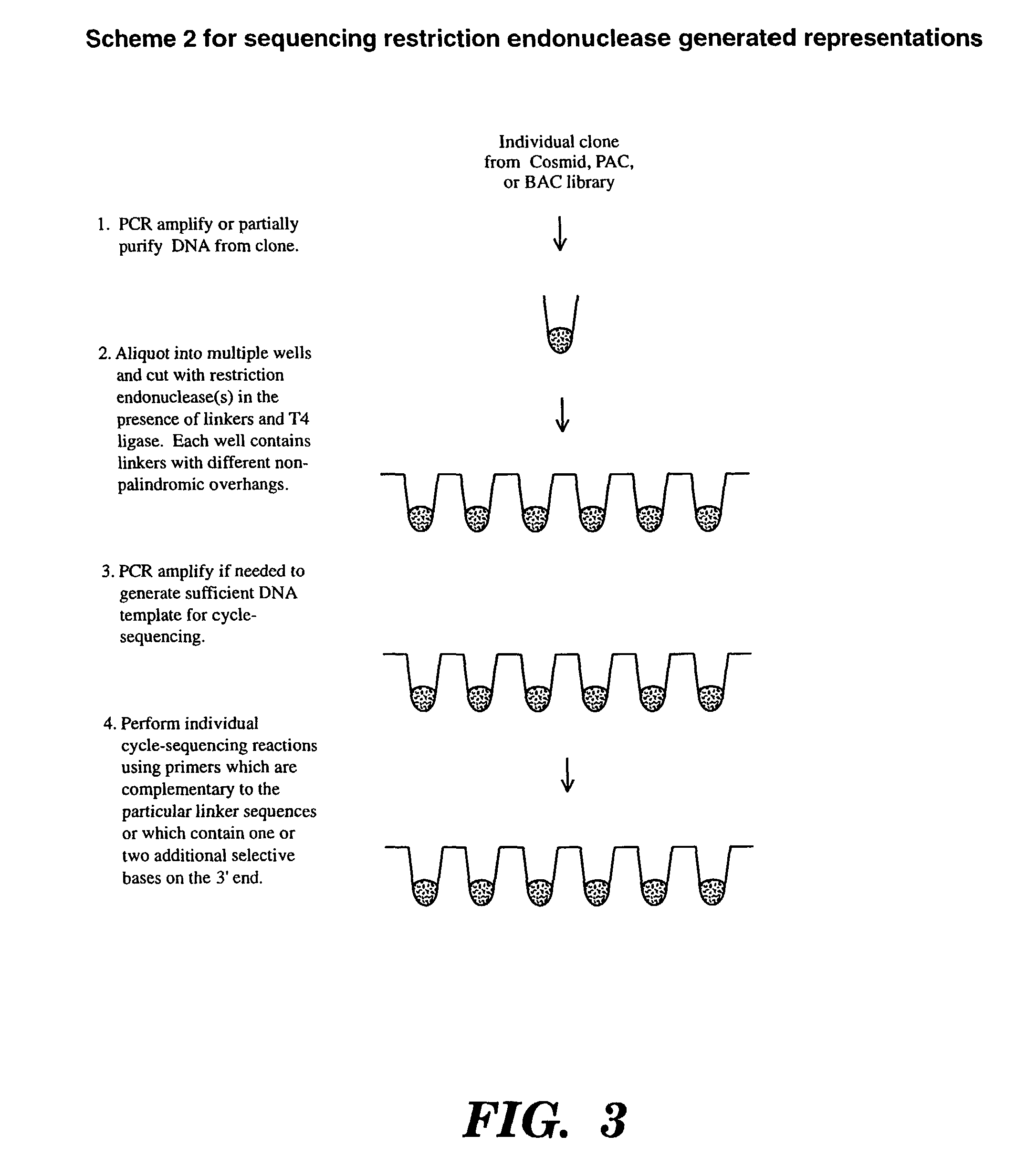Accelerating identification of single nucleotide polymorphisms and alignment of clones in genomic sequencing
a single nucleotide polymorphism and genomic sequencing technology, applied in the field of accelerating identification of single nucleotide polymorphisms and alignment of clones in genomic sequencing, can solve the problems of generating aflp does not identify snps which are outside restriction sites, and solid phase primer extension also generates false positive signals from mononucleotide repeat sequences. ,
- Summary
- Abstract
- Description
- Claims
- Application Information
AI Technical Summary
Benefits of technology
Problems solved by technology
Method used
Image
Examples
example 1
Demonstration of T4 DNA Ligase Fidelity in Ligating Linker / Adapters to Only Their Complementary 2 Base 3′ Overhangs Using Synthetic Targets
[0401]Ligation reactions with T4 DNA ligase and a variety of linker / adapters (GG-, AA-, AG-, and GA-) and synthetic targets (Tables 13 and 14) were performed to determine the fidelity of T4 DNA ligase under various experimental conditions.
[0402]
TABLE 13DrdI and Msp / Taq Bubble linkers and PCR primers for BAC clonesPrimerSequence (5′→3′)BAA295′ TAG ACT GCG TAC TCT AA 3′(SEQ. ID. No. 77)BAA3034R5′ pA GAG TAC GCA GTC TAC GAC TCA GG 3′(SEQ. ID. No. 78)BAAP315′ CCT GAG TCG TAG ACT GCG TAC TCT AA 3′(SEQ. ID. No. 79)BAAP32-FAM5′ FAM-CCT GAG TCG TAG ACT GCG TAC TCT AA 3′(SEQ. ID. No. 80)BAC335′ TAG ACT GCG TAC TCT AC 3′(SEQ. ID. No. 81)BACP355′ CCT GAG TCG TAG ACT GCG TAC TCT AC 3′(SEQ. ID. No. 82)BACP36-FAM5′ FAM-CCT GAG TCG TAG ACT GCG TAC TCT AC 3′(SEQ. ID. No. 83)BAG375′ TAG ACT GCG TAC TCA AG 3′(SEQ. ID. No. 84)BAG37b5′ Biotin-C18-ACT GAG TCG TAG ACT...
example 2
Demonstration of Restriction Digestion and Specific Ligation of Linker / Adapters to Their Complementary Overhangs Followed by PCR Amplification of the Correct Fragment
[0405]Specificity and reproducibility of DrdI Restriction / Ligation / PCR were tested in two vectors (pBeloBAC11 and pBACe3.6) and a BAC clone. BAC DNA (5-10 ng) was digested with DrdI, MspI, and TaqI and, simultaneously, ligated with 500 nM of the appropriate linker / adapters in the presence of T4 DNA ligase. Linker / adapters containing 2 base 3′ overhangs complementary to the DrdI site (BAA29+BAA3034R for AA overhangs, BAC33+BAA3034R for AC overhangs, BAG37+BAG38R for AG overhangs, BCA41+BCA4246R for CA overhangs, BGA45+BCA4246R for GA overhangs, and BGG49+BGG50R for GG overhangs) are listed in Table 13. Linker / adapters containing 2 base 5′ overhangs complementary to the CG overhang of MspI or TaqI sites (MTCG225+MTCG0326R or MTCGp326R) are listed in Table 8. The MTCG225 / MTCG0326R and MTCG225 / MTCGp326R linker adapters cont...
example 3
Suppression of Amplification of Vector Derived Sequence While Amplifying the Correct Fragment
[0409]The PCR amplification of DrdI fragments derived from the vector sequence were suppressed using PNA or propynyl clamping oligos. A slightly modified protocol was used when PCR amplifying DrdI fragments containing AA, CA, or GA overhangs from BACs derived from the pBeloBAC11 or pBACe3.6 vector. The pBeloBAC11 and pBACe3.6 vectors both contain DrdI sites complementary to AA-, CA-, and GA-overhangs, and amplification of these vector fragments needed to be suppressed. Clamping oligos which bind specific DrdI fragments (i.e. vector derived) and block annealing of PCR primers, were designed as PNA or propynyl derivatives (Tables 5 and 6).
[0410]BAC DNA (5-10 ng) was digested with DrdI, MspI, and TaqI and simultaneously ligated with 500 nM of the appropriate linker / adapters in the presence of T4 DNA ligase in a buffer containing 20 mM Tris-HCl (pH 7.5), 10 mM MgCl2, 50 mM KCl, 10 mM dithiothrei...
PUM
| Property | Measurement | Unit |
|---|---|---|
| Temperature | aaaaa | aaaaa |
| Volume | aaaaa | aaaaa |
| Molar density | aaaaa | aaaaa |
Abstract
Description
Claims
Application Information
 Login to View More
Login to View More - R&D
- Intellectual Property
- Life Sciences
- Materials
- Tech Scout
- Unparalleled Data Quality
- Higher Quality Content
- 60% Fewer Hallucinations
Browse by: Latest US Patents, China's latest patents, Technical Efficacy Thesaurus, Application Domain, Technology Topic, Popular Technical Reports.
© 2025 PatSnap. All rights reserved.Legal|Privacy policy|Modern Slavery Act Transparency Statement|Sitemap|About US| Contact US: help@patsnap.com



